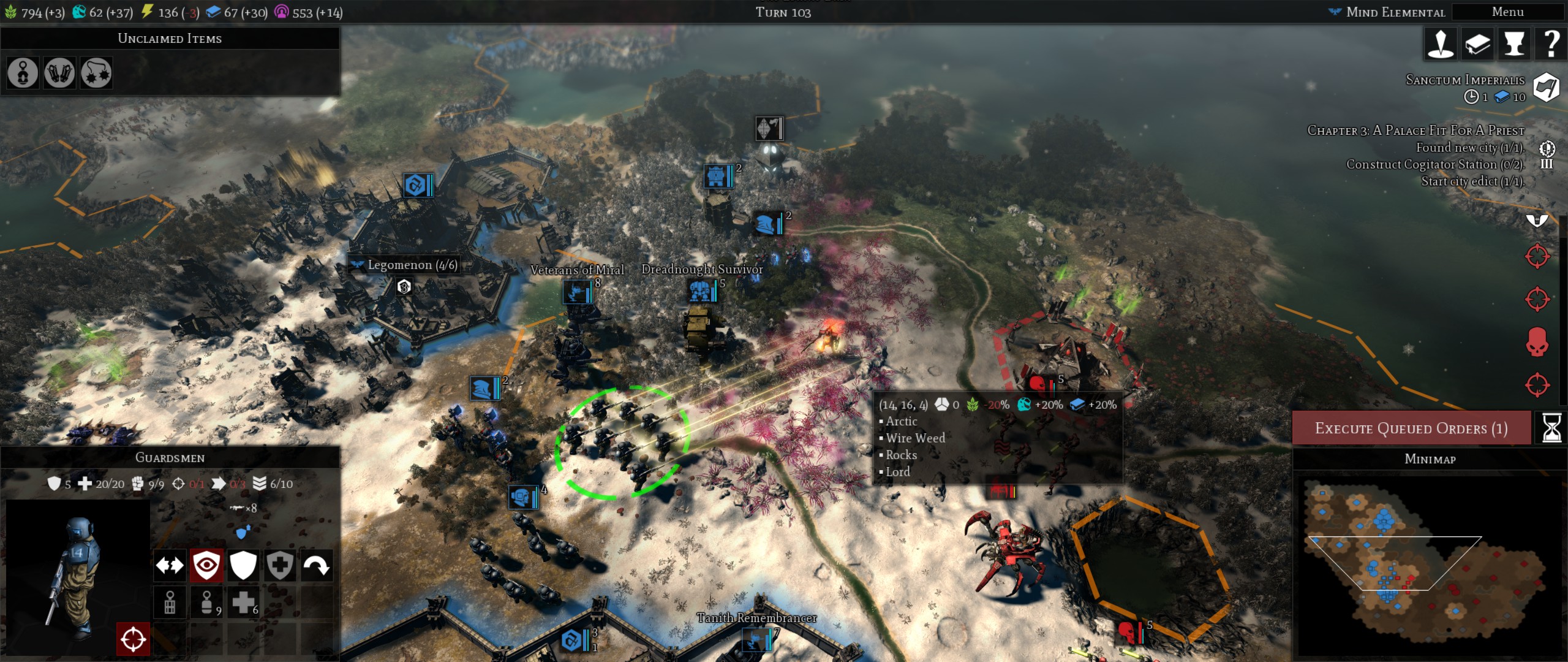- Quick thoughts: Warhammer 40K: Gladius
After recently playing a practice game, I have mixed feelings about Warhammer 40,000: Gladius – Relics of War:
- On the one hand, it’s decent to good at what it does: a blend of hex-based wargame, turn-based strategy game with base building, and the 40K setting.
- On the other hand, I’m not certain that blend works as well as a dedicated wargame or 4X game; and it takes longer to play than a real-time game would.
What 40K: Gladius does: turn-based, hex-based combat
I often see Gladius described as a “4X” game, a label I wouldn’t use. Instead, it feels like a cross between a beer-and-pretzels hex-based wargame and — this will sound slightly contradictory — a turn-based version of an RTS.
Like an RTS or a 4X game, players in Gladius build cities and collect resources. But a resource called “loyalty” constrains building and expansion to an extent that felt punitive: the optimal number of cities is quite small, probably only three. Instead, the focus is squarely on recruiting an army and fighting neutrals and other players.
This is where the “hex-based wargame” part comes in. Units have multiple traits: figures per unit, armour, hit points, different weapons each with their own damage and armour penetration, switchable ammunition types, abilities such as overwatch fire, and more. Playing as the Imperial Guard felt thematic:
- Basic guardsmen were weak, but useful for screening punchier units.
- Heavy weapon teams were my main killing force in the early- and mid-game, especially when I could take advantage of their long range.
- Later in the game, tanks and artillery took over as the stars of the show.
The base game includes four factions: the Imperial Guard, Space Marines, Necrons, and Orks. Other factions, and more units, are available via DLC1.

Like a more ponderous RTS
Putting these pieces together, my Gladius game resembled the progression of an RTS match: build up, fight off attacks, build an overwhelming force, and win the game.
- I set up a four-player game with myself, a computer-controlled Space Marine ally, and two enemy players — one Necron and one Ork.
- I started in a safe corner of the map, facing no threats other than neutral monsters. This let me work out how to play the game, while my ally fought off the Orks.
- Amassing a horde of guardsmen, heavy weapon teams, and scout walkers let me roll over the Orks through sheer numbers — although not in time to save my ally.
- But when a large Necron force showed up, it was time to run. My army staged a fighting retreat back to friendly territory, helped by a few Space Marine remnants. The survivors stood, inflicted heavy losses on their attackers, and held their ground.
- Once I saved up enough to field several tanks, nothing could challenge their massed firepower. At this point, I steamrolled the rest of the map.

I enjoyed this, but I’m not sure I’d play again. Next to comparable genres:
- Compared to an RTS, Gladius is much longer (a single game took me over 8 hours, per Steam) and more ponderously paced.
- Compared to a turn-based 4X game, building and exploration — two of my favourite parts of the genre — are lacking. In a game this focused on warfare, they are means to an end, not satisfying systems in their own right.
- And compared to a wargame, the need to fiddle with city management is a distraction from what the game does well: combat.
Conclusions
Does Gladius suffer from a contradiction in its design, or am I simply not its target audience?
If you’d like to see for yourself, the base game periodically goes for free (this is how I received it), or on sale for less than A$5. At the right price, this is still probably worth a look.
- I was a little disconcerted to see that the game requires DLC to unlock some of the more iconic units, such as stormtroopers and Chimera APCs for the Guard, or Land Raiders for the Space Marines ↩︎
Discover more from Matchsticks for my Eyes
Subscribe to get the latest posts sent to your email.